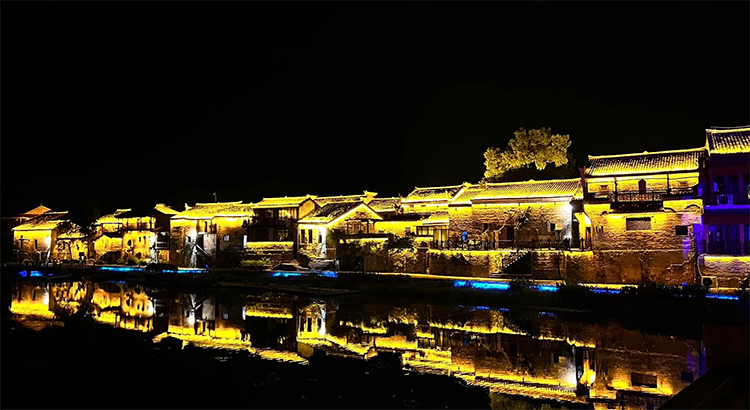Discover Rural Cultural Tourism in Meibi Ancient Village: Red Bricks & Farming Heritage
Introduction
When morning light skims the flying eaves of horse-head walls and the red-brick lanes curve beneath your feet, Meibi Ancient Village opens like a hand-bound scroll—367 Ming and Qing buildings whispering eight centuries of stories in the Gan dialect. There are no crowds here, only the lingering ink scent on ancestral hall lintels, shifting light in the academy courtyard, and a flock of egrets startled by laundry thumps beside the lotus pond. If you want to touch the freshest textures of China’s agrarian civilization, this living museum of red bricks, black tiles and green fields awaits your decoding.
1. Soul Colors: Decoding Meibi’s Visual DNA
Red: Unlike Jiangnan’s pale white walls, Meibi’s homes boldly use red sandstone for exterior walls; the contrast of dark tiles and vermillion creates a fierce vitality against the green fields. The material resists rot and damp and also carries the local wish for prosperity.
Ancient: Founded in the early Southern Song, Meibi retains about 90% Ming and Qing structures. From the carved moon beams of Yongmu Hall to the bagua ceiling in Wenchang Pavilion, every mortise and tenon tells of Gan merchants’ unique tradition of commerce married to scholarship.
Green: The Fushui River encircles the village like a natural moat, while the ancient camphor cluster on Houlong Mountain forms an ecological barrier. In spring you’ll find rapeseed seas, in summer moonlit lotus ponds, and year-round farm scenes that play off the ancient architecture.
2. Architectural Epic: The Gan Merchant Code in Yongmu Hall
Meibi’s building cluster is famed for its “one ancestral hall, seven courtyards, eighteen chambers” layout; Yongmu Hall is the peak of Gan clan ancestral architecture:
– The grand plan of three courtyards deep and five bays wide showcases family power; the lintel panels carved with “Loyalty, Filial Piety, Integrity” were set with a rice-and-lime paste that has resisted six centuries of weather.
– Look up at the main hall’s moon beam: its three-tiered openwork carving shows the scene of General Guo Ziyi paying birthday respects—figures frozen in flowing robes, a family’s visual pursuit of blessings and longevity.
– The most ingenious feature is the drainage: “coin-eye” floor drains at the courtyard corners channel rain into hidden channels, honoring feng shui’s “four waters return to the hall” idea while keeping walls dry.
Wenchang Pavilion reveals Meibi’s reverence for learning: this three-story pavilion once housed ten thousand volumes, and a bronze bell on its roof still rings in the wind, as if summoning the voices of scholars practicing their morning readings.
3. Living Farming: Living by the Solar Calendar
Meibi’s charm is that it is not just a museum but a breathing rural community:
– Qingming: After ancestral rites at the hall, villagers brew “Qingming wine” from red yeast rice; its aroma drifts from cellars and fills the lanes.
– Dragon Boat Festival: Ancient-style dragon boat races reappear on the Fushui River while vendors sell alkaline-water zongzi made by old methods.
– Autumn Harvest: The threshing ground turns into a natural stage; masks of nianxi (ritual theater) flicker in firelight as villagers perform rites to drive away evil and invite fortune.
We recommend a dawn walk at 6:00: watch elders sweep bluestone paths with bamboo brooms, hear the stove’s crackle, and catch the clanging rhythm from the blacksmith—these sounds form Meibi’s truest morning song.

4. Practical Guide: Live a Day as a Meibi Villager
Transport:
– From Ji’an West Station take the Qingyuan District tourism shuttle (about one hour direct), or self-drive to the scenic signposted “Meibi Ancient Village” (look for rapeseed viewing platforms along the route).
Sightseeing:
– Highlights Route (2 hours): Village entrance → Fushui River covered bridge → Yongmu Hall → Wenchang Pavilion → General’s Hall → Ming-Qing alleys
– Deep Experience (full day): Add the Agricultural Museum, try pounding glutinous rice cakes or traditional oil pressing, and spend the night in a Gan-style guesthouse to hear the night watchman’s clapper.
Tickets:
CNY 60 (includes guided access to five key buildings); student half-price. Every Wednesday afternoon there is an intangible cultural heritage demonstration: summer-cloth weaving and fish-lantern making.
Food & Lodging:
– Try Meibi’s “Three Delicacies”: red yeast rice pork (fermented red rice pork), lotus-pouch fried fish, and mugwort rice cakes.
– Recommended stay: “General’s Residence Guesthouse,” a Republican-era courtyard conversion—sip a pot of gougunao tea in the courtyard, and under the stars leaf through the owner’s handwritten genealogy.
5. When to Visit? Every Season Is Picturesque
– March–April: The village set in rapeseed blooms looks like an amber village on a golden carpet.
– June–August: Lotus blooms along the Fushui River and fireflies dot summer nights.
– September–October: Autumn drying season leaves roofs strewn with red chilies and golden corn.
– November–February: Snow on horse-head walls and warm ancestral-hall hearth gatherings make winter intimate.
Avoid China’s National Day holiday (Oct 1–7) to enjoy the village’s quiet—on weekdays visitor numbers often stay below a hundred.

Conclusion
In Meibi, time does not simply pass—it settles into Yongmu Hall’s brick carvings, cycles through the twenty-four solar terms, and inhales and exhales from every slab of red sandstone. As modern China rushes forward, this village stubbornly preserves the DNA of agrarian life, inviting you to a deliberate, cross-century encounter.


